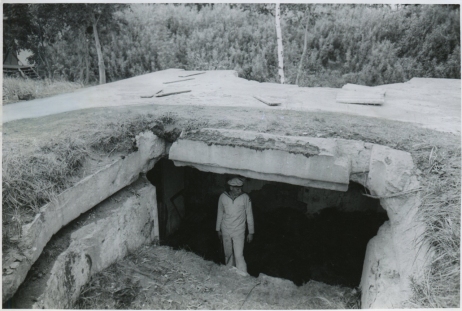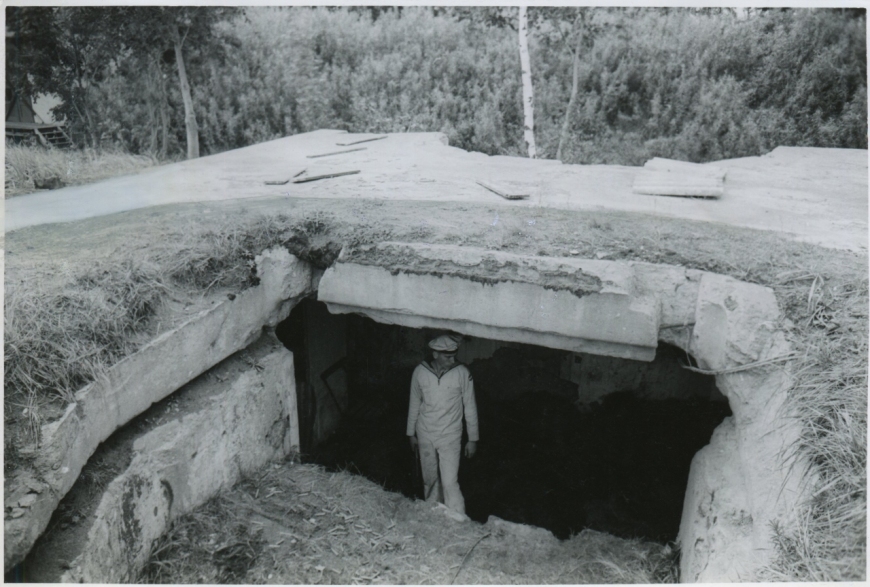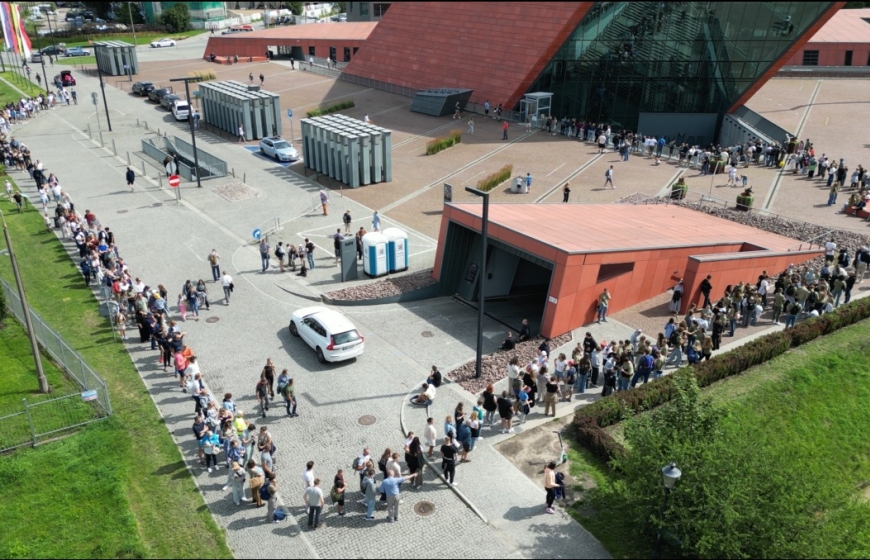#WESTERPLATTEHISTORY - RIFLEMAN MIECZYSŁAW KRZAK
The Polish defenders of the Military Transit Depot in Westerplatte who were killed. Rifleman Mieczysław Krzak.
The story of another of the fallen Polish defenders of Westerplatte perfectly illustrates the dynamics and drama of the fight against the German invaders in September 1939. Importantly - no more than only 20 of the garrison members, who were mainly civilian employees (reservists) and only 4 officers and non-commissioned officers of the permanent garrison , had combat experience - drawn mainly from the Polish-Soviet war of 1920. Few of them began their military careers on the fronts of World War I. Almost all the rest of the crew had never participated in combat operations, and the maneuvers and field training in which they participated in only to a small extent prepared them for what was to come.
We invite you to learn about the history of Rifleman Mieczysław Krzak, who – just as all of the defenders of the Military Transit Depot - stood fast at his post with the highest commitment and devotion, defending this piece of Poland.
Mieczysław Krzak, a rifleman, was born on January 29th, 1915 in the village of Boiska (Solec commune, Lipski poviat, now in the Mazowieckie region). He was the son of Tomasz and Marianna née Figura. He served in the army in the 4th Legion Infantry Regiment in Kielce. He arrived at Westerplatte on April 5th, 1939 as a mortar gunner. Originally he was assigned to the 8th brigade of the 3rd platoon. As part of this, he dealt with the handling of accompanying infantry weapons, in this case with the handling of mortars that had been secretly delivered to Westerplatte. Based on preserved documentation and on the accounts of colleagues, it can be concluded that he was most likely a sighting observer. After a temporary reorganization of the defense systems, Westerplatte (due to the destruction of mortar positions and the demolition of guardhouse No. 5 on September 2nd, 1939) was incorporated into the newly created defense point in the area of the railway tracks and warehouses No. 12–15. This position was organisationally subordinate to the platoon mortar commander Józef Bieniasz and was one of the few additional posts in this area that ensured the maintenance of the fortified core of the Military Depot. He died in an unspecified place near the outpost known as the ‘Fort’ (most likely to the east of it) not earlier than in the afternoon of September 2nd, 1939. The exact date of his death, however, is uncertain - according to some reports, he may have died some time during the following days. He was supposed to have been temporarily buried by Poles, and after the fighting he was declared missing. Most likely, his body was found during the cleaning works at Westerplatte and, for unknown reasons, he could have been burned in the same location. This was supposed to have taken place only at the beginning of 1940, which can be confirmed by at least two independent accounts of witnesses. It should therefore be assumed that the remains of this fallen soldier and others may still be somewhere on the peninsula, and all possible steps should be taken to find them and properly bury them at the newly created cemetery on Westerplatte.
The key to knowing the circumstances of the death of Rifleman Krzak is a thorough reconnaissance of the situation in the foreground area of the destroyed guardhouse No.5 and the location of the elimination of its garrison. These would have been at the following locations: the railway tracks, Deika, Bieniasz and, at some distance to the west, the position and crew of a 37 mm anti-tank gun. In addition, there were several individual firing positions there - it was most likely in one of these positions that Rifleman Krzak was fatally shot. There are more well-known accounts of these events from the comrades-in-arms of Rifleman Krzak from the 8th Brigade; Rifleman Bartocha, Rifleman Jankowicz, and Rifleman Borowiec.
It is worth noting two less widespread accounts of Rifleman Krzak, which complete the picture of the complex battlefield at Westerplatte. At the same time, they illustrate the problems faced by researchers, who can only operate on a wide range of memoirs written after the war. The first fragment comes from an account from the above-mentioned Rifleman Bartocha in correspondence dated July 25th, 1960. Interestingly, the Westerplatte defender does not refer to the death of his colleague there.
„On the first day of the outbreak of the war, I fought with mortars as a gunner at the barracks. After the mortars were bombed, I was assigned to a machine gun as a gunner with a loader, whose name I remember, Krzak, and I fought there until the end, that is until September 7th, 1939. I do not remember the name of the commander. [...] I remember my colleagues: Corporal Stradomski, Łuczyński, and platoon member Naskręt.”
Another interesting account was made by another of the comrades of Rifleman Krzak - senior Rifleman Józef Kuter - in the 1960s. After handling mortars, he was at a so-called position of safety as described in the following excerpt:
„During the first days of the fighting at Westerplatte, I was assigned to the mortars. The mortar commander was platoon leader Bieniasz. After the bombing of the 5th guardhouse, I was assigned to a concrete shelter. The commander there was platoonist Baran and I was there until the surrender. As for the mortars, I only remember Porada, Gajda and Krzak, and in the shelter there were Porada, Gajda, Krzak, Zwierzchowski, there were eight of us altogether there, but I don't remember all of the names, only that Krzak was killed at the shelter.”
These accounts illustrate perfectly how much work still awaits researchers who want to clarify further mysteries at Westerplatte. We should also remember that due to their utmost dedication, like all of the other Polish defenders of Westerplatte, Rifleman Krzak was honoured by the Supreme Command of the Polish Army No. 749 of August 30th, 1945, and posthumously awarded the Virtuti Militari Order of the 5th class.
List of the 8th team of the 3rd platoon on Westerplatte:
|
Rank |
Surname and Name |
Where he served on Westerplatte, function, speciality |
Personal number in the 8th team of the 3rd platoon |
|
corporal |
Bieniasz Józef |
mortars, platoon commander, outpost at the railroad track, personal weapons |
1/8/III |
|
senior corporal |
Gonsowski Michał |
mortars, gunner (?), personal weapons |
2/8/III |
|
corporal |
Bałtowski Stanisław |
mortars, gunner commander, gunner, personal weapons |
3/8/III |
|
corporal |
Włodarski Wojciech |
mortars, gunner commander, gunner and machine gunner, secondary weapons |
4/8/III |
|
corporal |
Zwierzchowski Stanisław |
mortars, gunner commander, gunner, secondary weapons |
5/8/III |
|
corporal |
Zimny Stefan |
mortars, gunner, gunner and gunner commander, personal weapons |
6/8/III |
|
senior rifleman |
Kolasa Stanisław |
mortars, "Ferry" facility, barracks, gunner, personal weapons |
7/8/III |
|
senior rifleman |
Kutera Józef |
mortars, gunner, personal weapons |
8/8/III |
|
rifleman |
Borowiec Piotr |
mortars, service, personal weapons |
9/8/III |
|
rifleman |
Gajda Stefan |
mortars, heavy machine gun sighting - no detailed information (?), servicing, personal weapons |
10/8/III |
|
rifleman |
Bartocha Stanisław |
mortars, guardhouse No. 6, heavy machine gun sighting, gun sightin, personal weapons |
11/8/III |
|
rifleman |
Jankowicz Józef |
mortars, service, accompanying weapons |
12/8/III |
|
rifleman |
Krzak Mieczysław |
mortars, barracks, the ‘Fort’ facility, servicing, personal weapons |
13/8/III |
|
rifleman |
Soja Franciszek |
junior sapper, servicing, personal weapons |
14/8/III |
|
rifleman |
Łojek Franciszek |
mortars, guardhouse No. 3 (?), sighting, personal weapons |
15/8/III |
|
rifleman |
Cieśliński Jan |
mortars, loader, servicing, personal weapons |
16/8/III |
|
rifleman |
Porada Jan |
mortars, gunner, servicing, personal weapons |
17/8/III |
|
rifleman |
Grudzień Józef II (son of Marcin) |
mortars, gunner, personal weapons |
18/8/III |

















